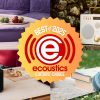The intent of this article is to simplify vibration control and how it is applied to home audio. Are you confused by vibration control products? In this article I’ll share knowledge about isolation, damping, structural rigidity, mass and spikes. How each can be used to get better sound through vibration control.
You may know with firsthand experience that vibration effects sound, but how? Sound is vibration which interacts with HiFi gear; that’s why isolation products are popular. Take a look at Bandit’s use of cork isolators under his NAD C 326BEE integrated amplifier. Picture footfalls and thumps that are picked up by your turntable; the same happens to all of your equipment.

Want better sound?
Identify which components are the most sensitive to vibration. Don’t assume because a component is extremely heavy or very lightweight that it will react the same way to vibration.
Start by placing isolation feet under each component; does the sound change?
Allow this change for at least 3 days and listen for any differences in the sound. I prefer to give it 7 days, but every situation is different.
Then remove one set at a time; one change at a time and give it 1 day or 3. What do you note? This is the secret to critical listening.
Tip: Not all equipment sounds better isolated; some gear sounds better coupled.
Be mindful of that fact that every surface resonates at a different frequency. A wood shelf will have a different impact on the sound than a glass shelf.
Vibration influences sound; okay — this is easily detectable in turntables, but what about solid-state gear? Sound waves created by loudspeakers generate mechanical vibration that couple with floors, component shelves, and HiFi equipment. Solid state circuitry and printed circuit boards are susceptible to vibration through microphonic effects. Vibration influences low level currents which travel through the signal chain into your speakers. Isolation is important.
Other than isolation, how can you reduce vibration?
When vibration is present and coincident with a resonant frequency, that vibration is amplified (think of the Tacoma Narrows Bridge). Reducing vibration at resonance requires damping. Thin speaker boxes and lightweight cabinets will be resonant; even very good cabinets will be. To counteract vibration, damping material is applied to the surfaces to absorb vibration (and turn this into small levels of heat).
Danny Richie of GR Research sells NoRez. Dynamat is another popular brand of damping material. Also, sand, rice or kitty litter inside of a hollow speaker stand or embedded between layers adds damping. Damping takes the ‘ring’ out.
Not only is damping material applied inside speaker cabinet but is very mainstream in car audio too.

Isolation vs. Damping: Resonance and Structural Rigidity
Isolation prevents transmission of vibration from one object to another; precision microscopes are isolated to the 99th degree. A drawback to isolation is that if the isolated component produces vibration that vibration is amplified. Think of an air conditioner unit mounted on a rooftop or emergency generator on springs. Isolate your speakers or audio furniture to prevent coupling of floor vibration.
Damping absorbs vibration; this is only effective at resonance. Resonance occurs when a vibration frequency matches a natural frequency. A thin wall speaker cabinet will have resonances at lower frequencies (modes) than a thick one with internal bracing. The speaker vibrations will excite cabinet resonance and the cabinet will vibrate and create its own sound; people refer to this as coloration or distortion.
Well-built cabinets resonate too, but at much higher frequencies which result in lower vibration amplitudes with less influence on the sound. Consider adding internal bracing to large cabinets. Then add damping material inside the cabinet walls to absorb higher frequency vibrations. Great speakers will not ring when you tap on the cabinets; great cabinets are very inert.


Weight and Mass: Is Heavier Better?
Heavier is better. A heavier speaker, platform, plinth, or cabinet absorbs oscillations and vibration.
Remember F=ma, or acceleration=force\mass. Acceleration is a measure of vibration. Vibration is a response to applied forces; more SPL, more force, more vibration. Add mass to absorb those forces to lower vibration transmission. A heavy speaker cabinet and speaker stand will absorb speaker vibration so less travel into the floor. A heavy audio cabinet will absorb floor vibrations and provide stability. Isolation will prevent vibration transmission into your HiFi equipment. A turntable base is heavy to stabilize the platter. A record weight stabilizes a vinyl LP. All of these things work in concert and have an impact on the sound.

About Rigidity
An audio cabinet needs to be sturdy enough to support the weight of the gear, especially a lot of gear and vinyl LPs; like Eric Pye’s system shown below. Static rigidity supports weight and prevents sag, rocking, twisting or bucking.
Rigidity, or the structural stiffness effects the resonant frequencies. Increasing stiffness increases the resonant frequency which results is lower vibration in audio systems.

Spikes and Coupling
Spikes are not isolation. Not in the way you might think. Isolators are typically soft and very flexible.
Cork, Sorbothane, foam and soft springs to name a few. These materials will not support the large weight of speakers and cabinets; they’ll just compress. Spikes are used to support heavy items and reduce vibration transmission from one component to another by reducing the coupling contact area.
Spikes are very advantageous and serve to influence microphonic effects when placed strategically on the underside of equipment enclosures. Cones are like spikes, but simply have greater contact area.
Carbon fiber is an excellent material for cones which absorb vibration through damping and are used throughout auto racing, sports (hockey sticks, skis, and tennis rackets), and in some pieces of audio equipment. Carbon fiber has very high rigidity to mass and is also an electrical isolator.
You’ve probably noticed that some manufacturers have begun to use carbon fiber in the design of their tonearms, loudspeaker cabinets, and isolation platforms; the tonearms are very lightweight but also extremely rigid in their construction.
Ball bearings serve a similar function; there is no end to the variation of vibration control solutions available.

Coupling
Coupling is the amount one surface exactly matches another when in contact. Vibration transmission is improved with coupling; hence it is the opposite of isolation. By reducing coupling contact area, transmission will be reduced. Beeswax can be used to increase coupling by filling in tiny holes, porosity and imperfections between two surfaces.
Coupling can also reduce slip or differential motion between two surfaces. Speakers should be coupled to speaker stands which should be isolated from floors. Turntables can be coupled to isolation platforms which should then be isolated from the stand.
In all things audio, it’s personal preference to isolate, couple, add mass, and whatever. My hope is to equip you with the science behind treatments so you can identify what’s best for you to improve your sound.
Stumped by something or odd application?
Throw it up on Instagram and tag me @audio_acoustic_engineering – I’ll be sure to review and comment.




































